Arieh Merzer (1905-1966)
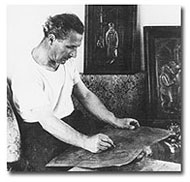 Arieh Merzer,
an artist who worked in hand-hammered copper, was born in Warsaw
in 1905, the scion of a large Hassidic family. He graduated from
the Academy of Arts in Warsaw, and became the pupil of Professor
Adam Richtarsky. He later worked with a group of Jewish artists
who wanted to resuscitate the ancient oriental-Jewish craft of hand-hammering
metal (metaloplastics), which was passed on to us as a legacy by
far-off generations from the time of the Bible.
Arieh Merzer,
an artist who worked in hand-hammered copper, was born in Warsaw
in 1905, the scion of a large Hassidic family. He graduated from
the Academy of Arts in Warsaw, and became the pupil of Professor
Adam Richtarsky. He later worked with a group of Jewish artists
who wanted to resuscitate the ancient oriental-Jewish craft of hand-hammering
metal (metaloplastics), which was passed on to us as a legacy by
far-off generations from the time of the Bible.
In 1928 Arieh Merzer exhibited his works in Warsaw for the first
time. From 1930 he lived and worked in Paris. He was one of the
Jewish artists who gathered there and were known as the Jewish 'Ecole
de Paris.'
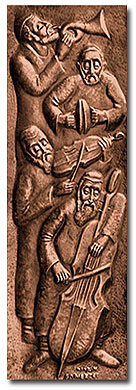 Merzer regularly exhibited in the well-known 'Salon d'Automne'
and 'Salon des Tuileries,' as well as in solo exhibitions in Paris
and throughout France.
Merzer regularly exhibited in the well-known 'Salon d'Automne'
and 'Salon des Tuileries,' as well as in solo exhibitions in Paris
and throughout France.
Arieh Merzer's work was highly acclaimed well before the Holocaust,
before it became a memorial to a world destroyed. He portrayed the
story of the Jewish spirit on copper, on silver, and on gold: stories
from the Bible, the life-styles of the Jews in their shtetls and
ghettos, of Hassids and Kabbalists of renown, of wars of liberation
and revival. A special stress was placed on the link between the
new Jewish experience and its historical nucleus. His major innovation
was the moulding of mystic and traditional Jewish motifs, that surrounded
the Holy Ark in Europe's burning synagogues, and presenting the
results before the world of modern art. As a result he became generally
recognized as an international Jewish artist. In 1943, when France
was conquered by the Nazis, Arieh Merzer escaped from a concentration
camp, and after a stint in the maquis, he crossed the border into
Switzerland and was sent to a labor camp. Later, he arrived in Geneva,
where an album of sketches of his works was put out. In 1945 he
made aliyah to Israel with his family, settled in Safed, and helped
to found the Artists' Quarter there.
Arieh Merzer lived and worked in Israel for twenty-one years. His
exhibitions in the country include: 1946 in the Tel Aviv Museum;
1947 in the Pevsner Artists' Pavilion in Haifa; 1951 in the Artists'
Pavilion in Tel Aviv; 1955 in the Museum for Modern Art in Haifa;
1955 in the Artists' Pavilion in Jerusalem; and 1957 in the Tel
Aviv Museum. His works were also on permanent show in his atelier
in Safed. He was awarded prizes, including: the Herman Struck prize
in 1946; the Dizengoff prize in 1951 and then again in 1965; and
the Mayor of Haifa's prize in 1954. His works appear in numerous
museums and collections throughout the country and abroad. His heart
stopped beating on the eve of Holocaust Day, 1966.
Arieh Merzer, who was brought up in a Hassidic family, was drawn
to the world of art from an early age; he was influenced by the
moods and new ideals of the socialist circles and prepared himself
to study art in the academy. On Passover eve , after clearing out
the bread, while the rest of the household was busy preparing for
the Holiday, a book fell from the bookcase and from out its pages
flew dozens of sketches and drawings of nudes that the young Arieh
had prepared for his folio for the entrance examinations to the
academy. His sisters tore up the drawings with cries of treyfe treyfe
(ritually non-kosher) and many months' hard work went down the drain.
As a result of this, he left his home at the age of fifteen, and
later joined a group of young artists who wanted to revive the ancient
art of hand-hammered copper - metaloplastics - bequeathed to them
by past generations who lived in Bible times.
Thus did he part from his family - mother, father, thirteen brothers
and sisters - who all perished in the Holocaust. He alone survived,
and made an oath that he would commemorate in copper all who had
died.
Arieh Merzer wrote:
"From my earliest childhood I remember a little volume
in my father's library which always intrigued me with its strangely
drawn figures and circles. When ever my father hid it behind the
heavy Gimorahs I pulled it out again and again. It was in the book
of Kabballah "Raziel the Angel" that for the first time
I came across plastic art.So, perhaps, it is not by chance that
almost forty years later, after the old Jewish homes in Europe together
with their inhabitants were destroyed in fire and in smoke, fate
led me to the Kabballah city of Safed: The city which crowns the
thoughtful inspiring mountains of Galilee with her old Synagogues,
surrounded by caves and ancient tombs from the time of the wise
man and teachers (Shimon Bar-Yochai, his son and pupils Shmaiah
and Avtalion and many others). Safed with her mystic stories and
legends where Moshe Kordovero and the Ari Hajadosh studies Kabballah
with their pupils, where the spirit of the mishna came each night
to Yosef Karo to study the secrets of the Torah with him, city where
Shlomo Alcabetz sang the great love song "Lecha Dodi"
to Queen Sabath. Safed the wonder-city where generations of Jews
came from the wide world to seek meaning and slavation - Therefore,
it is no wonder that this city, hundreds of years later, attracted
painters and artists from the whole world."
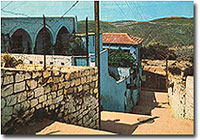
Arieh Merzer street in Safed
In the summer of 1946 whilst I was getting acquainted with Safed
for the first time, the city charmed me with her beautiful mysterious
folk, her little streets with their oriental-mediaeval architecture
and their wrought-iron balconies like fine embroidery.
I was fascinated by the patriarchal Jews, remnants from the old
Kabbalists who still walk in these Safed streets. 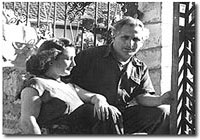
Arieh and his wife, Ester Merzer in Safed \ Merzer house in 1955
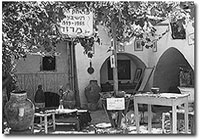
TO THE COPPER GREETING CARD COLLECTION SITE>>


